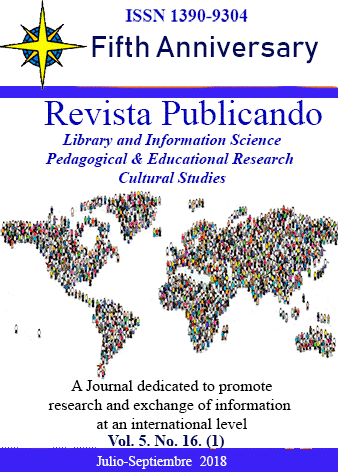Resumen
Approaches to the locus of control problem, future image in terms of life plans aggregate formation, their realization ways and methods determination studying are analysing in the article. The spatio-temporal component includes future development in space, that can be considered in terms of space range for life plans realization; organization, that is, life plans provision with means for their realization; extension of the future in time. There is shown, that the future image in students with internal locus of control is represented by a higher organization degree and a greater number of life plans, part of which is regarded as their realization means, and also that internals are more inclined to the future planning for long periods.
Referencias
Rotter, J.Ð’., 1992. Cognates of personal control: Locus of control, self-efficacy, and explanatory style: comment. Applied and Preventive Psychology, 2 (1): 127-129.
Butterfield, E.C., 1964. Locus of control, test anxiety, reactions of frustretion, and achievement attitudes. Jornal of Personality, 32 (3): 355-370.
Hasan, S.S., Khalid, R., 2014. Academic locus of control of high and low achieving students. Journal of Research and Reflections in Education, 8: 22-33.
Riesman, D., 1966. Individualism reconsidered and other essays. New York, Free press, 529.
Thayer, S., Zorman, B.S., Wessman, A.E., Schmeidler, Z., Mannucci, E., 1975. The relationship of locus control and temporal experience. Journal of Genetic Psychology, 126: 275-279.
Pantileev, S.R., 1987. Metody izmerenija lokusa kontrolja. V kn.: Obshhaja psihodiagnostika. М., MSU, 18, 23: 278-285. (In Russian).
Mehdi Mafi, “A Hierarchical Model of ICT in Digital Society to Access Information,” Canadian Journal on Electrical and Electronics Engineering, vol. 3, issue 7, 2012, pp. 366-374.
Bazhin, E.F., Golynkina, E.A., Jetkind, A.M., 1984. Metod issledovanija urovnja sub'ektivnogo kontrolja. Psihologicheskij zhurnal, 3: 152-162 (In Russian).
Karnauhov, V.A., Kanishheva, M.A., 2015. Osobennosti jemocional'nogo otnoshenija k vozmozhnomu budushhemu u ljudej s raznym lokusom kontrolja. Rossijskij nauchnyj zhurnal, 3(46): 135-139 (In Russian).
Nuttin, J., 1984. Motivation, planning, and action. A relational theory of behavior dynamics. Leuven, Leuven University Press; Hillsdale. New Jersey, Lawrence Erlbaum Associates, 251.
Nuttin, J., Lens, W., 1985. Future time perspective and motivation: Theory and Research Method. Lens. Leuven, Leuven University Press; Hillsdale. New Jersey, Lawrence Erlbaum Associates, 235.
M Tahmassebpour (2017). Detecting fault location in wireless sensor networks using an exploratory method based on fuzzy logic, Knowledge-Based Engineering and Innovation (KBEI), 2017 IEEE 4th International Conference on, 0465-0469
Golovaha, E.I., 2009. Zhiznennaja perspektiva i cennostnye orientacii lichnosti. V kn.: Psihologija lichnosti v trudah otechestvennyh psihologov. SPb., Piter, 162-169 (n Russian).
Rubinshtejn, S.L., 2016. Osnovy obshhej psihologii. SPb., Piter, 720 (In Russian).
Derevjanko, Ju.P., 2011. Smyslozhiznennye orientacii studentov s raznoj strukturoj perezhivanija vremeni. Nauchnye vedomosti Belgorodskogo gosudarstvennogo universiteta. Serija: Gumanitarnye nauki, 9, â„– 6 (101): 355-359 (In Russian).
Ginzburg, M.R., 1994. Psihologicheskoe soderzhanie lichnostnogo samoopredelenija. Voprosy psihologii, 3: 43–52 (In Russian).
Y Cao, MJ Esfahani, H Akbari, A Foroughi (2016). Detailed modeling study of low-velocity combustion of crude oil at different moisture content, Petroleum Science and Technology 34 (24), 1978-1983
Lewin, К., 2010. Resolving Social Conflicts and Field Theory in Social Science. Washington, American Psychological Association, 422.
Usted es libre de:
Compartir — copiar y redistribuir el material en cualquier medio o formato
Adaptar — remezclar, transformar y construir a partir del material
La licenciante no puede revocar estas libertades en tanto usted siga los términos de la licencia
Bajo los siguientes términos:
Atribución — Usted debe dar crédito de manera adecuada, brindar un enlace a la licencia, e indicar si se han realizado cambios. Puede hacerlo en cualquier forma razonable, pero no de forma tal que sugiera que usted o su uso tienen el apoyo de la licenciante.
NoComercial — Usted no puede hacer uso del material con propósitos comerciales.
CompartirIgual — Si remezcla, transforma o crea a partir del material, debe distribuir su contribución bajo la lamisma licencia del original.
